Eastern Conference
Atlantic Division
Central Division
Southeast Division
Western Conference
Northwest Division
Southwest Division
AFC
NFC
American League
National League
Replacing a Pittsburgh Steelers Legend

In a previous article, I wrote about Pittsburgh Steelers quarterback Mitch Trubisky and the chances of losing his job to rookie Kenny Pickett. In week two of the NFL season, the Steelers lost to the New England Patriots in Pittsburgh’s season home opener. Many fans were chanting “We want Kenny” as Trubisky had his second straight mediocre game.
As Ben Roethlisberger retired after the 2021 season, it was the first time since Terry Bradshaw’s final season in 1983 that the Steelers were faced with replacing a true “franchise” quarterback and finding the next great signal caller.
In some ways, Mitch Trubisky is beginning to remind me of former Steelers quarterback Mark Malone. Malone was the heir apparent to Bradshaw but turned out to be just an average quarterback whose performances were often so abysmal that fans turned on him. I can clearly recall driving around Pittsburgh during Malone’s tenure and seeing an effigy of the Pittsburgh quarterback hanging from a local bridge. That’s how much he was disliked.
Mark Malone might be the most unfavorable quarterback in the Steelers' history. Now it is Mitch Trubisky who while only having played two games for the Steelers thus far, has not shown any signs of being “special” in any way. Unlike Malone who did not have someone behind him with potential “star quality” as Kenny Pickett does, his job was never in danger because of who was carrying the clipboard for him.
That’s not the case for Trubisky who will be on the hot seat if his play does not improve and do so quickly. After week two Steelers head coach Mike Tomlin preached patience with the Pittsburgh offense but losses will play a major part in making a change at quarterback.
As for trying to replace the legends at quarterback for the Steelers, an injured Terry Bradshaw in 1983 which turned out to be his final year created the opportunity for Cliff Stoudt to take over. Stoudt was drafted the same year as Mark Malone but head coach Chuck Noll opted to go with Stoudt and not Malone who was drafted with Pittsburgh’s first choice in 1980 28th overall.
Stoudt and the Steelers finished 10-6 that year and won the then AFC Central Division only to get hammered by the Raiders in the divisional playoff round 38-10. Stoudt had a pretty decent campaign throwing for 2,553 yards and 12 touchdowns but also threw 21 interceptions and was sacked an eye-popping 51 times. He would be released by the Steelers and be out of the NFL for the next two seasons until the St. Louis Cardinals brought him onboard.
Stoudt’s release paved the way for Mark Malone to take over in 1984. Malone did split some time with David Woodley with Malone getting nine starts and Woodley seven. It’s unfortunate that Malone did not find the same success throughout his career that he and the Steelers saw in that first year of Malone as a full-time starter.
In 1984, Pittsburgh finished 9-7 winning the division again and then defeated the Denver Broncos to reach the AFC championship game. There they lost to Pittsburgh native Dan Marino and the Miami Dolphins 45-28 in what would be Marino’s only Super Bowl appearance. Ironically enough, the Steelers wanted to draft Dan Marino who attended Central Catholic High School in Pittsburgh and then the University of Pittsburgh. But reportedly, Chuck Noll thought Bradshaw had a few seasons left in the gas tank therefore they passed on Marino.
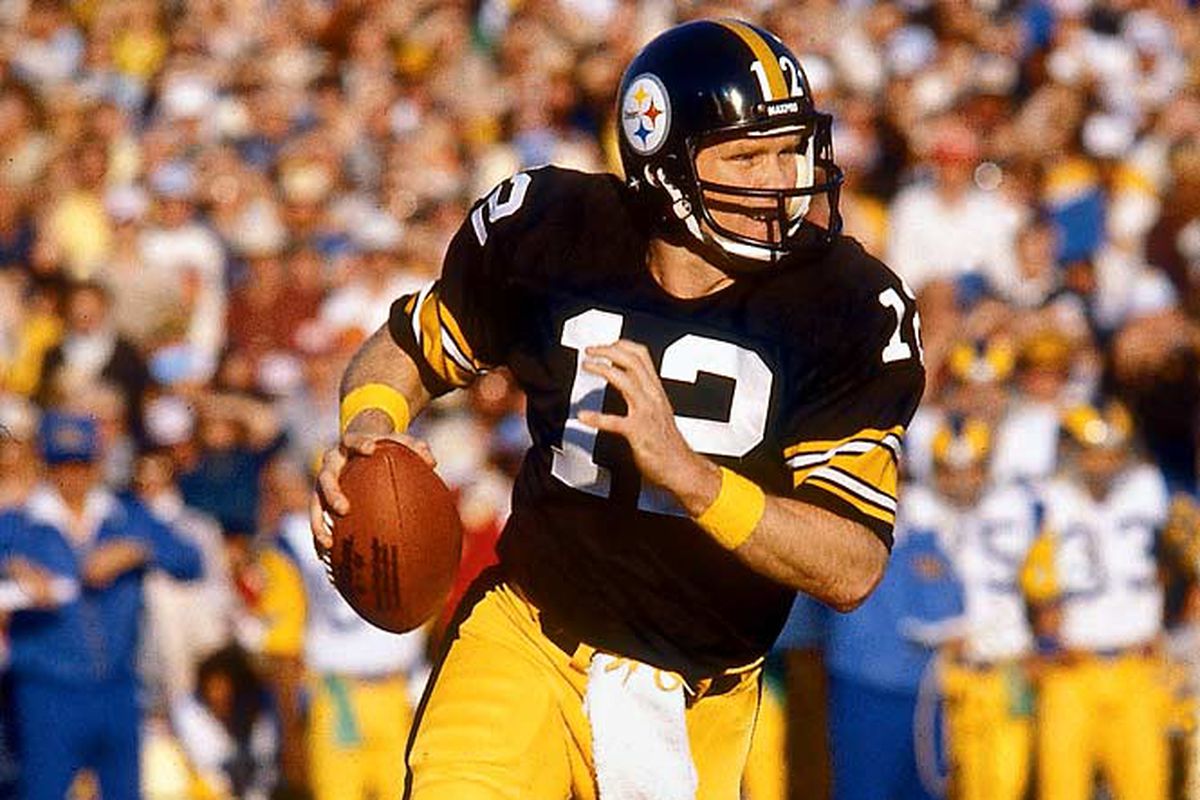
Steelers fans often wonder what would have been had Marino stayed home.
Fresh off a very successful season, in 1985 Malone’s decline began. The Steelers finished 7-9 and in third place in a division of four teams. Mark Malone started eight games and David Woodley started in six. Even newcomer Scott Cambell saw action starting two games as he came over from the Atlanta Falcons but after the season never played for the Steelers again.
As for Malone that season, his completion percentage was just 50.2% and his final yardage passing was only 1,428. His quarterback rating was only 75.5 but much better than Woodley’s 54.8. The next season in 1986 was even worse for the Steelers. With a 6-10 record, this was not the kind of season that Chuck Noll liked to endure.
Like Kenny Pickett this year, Pittsburgh drafted one Bubby Brister in the third round of the 1986 NFL draft from Tulane University (La-Monroe). Noll started Brister in two games but Mark Malone carried the bulk of the snaps behind center. Malone’s rating was worse than from a season before at 62.5. Malone also threw more interceptions than touchdowns (18 to 15).
Still looking for some backup to Malone, the Steelers brought in veteran Steve Bono who started in three games and performed much better than the incumbent Malone. Brister was not ready yet to take over but in 1987 Malone bettered his interception rate from the season before by throwing 19 more while connecting on only six touchdowns.
By the end of the 1988 season, head coach Chuck Noll must have felt like he aged 30 years as he saw his team win only five games and lose 11. With a last-place finish in the AFC Central Division, the Steelers were far removed from the successes of the 1970s. Noll had seen enough of Mark Malone and he ended up on the San Diego Chargers roster for the 1988 season before signing with the New York Jets where he played in just one game in 1989.

With Mark Malone no longer wearing Black and Gold much to the joy of Steelers Nation, Chuck Noll handed the reigns over to Bubby Brister. In his first full season as the starter, Brister became a fan favorite despite his stats not being that great (2,634 passing yards, 14 picks, 11 touchdowns, 65.3 rating).
In 1989 the Pittsburgh Steelers got off the losing side by posting a 9-7 record which was only good enough for third place in their division but it got them into the wild card round where they defeated the Houston Oilers 26-23 but then lost a close game to Denver in the divisional round 24-23. Bubby Brister was becoming more comfortable in the pocket and was improving slowly.
A season later Pittsburgh missed the playoffs again repeating their 9-7 record as Chuck Noll was eying the end of his coaching career. The Steelers roster was reduced to just two quarterbacks, Brister and Rick Strom. Strom was also a Pittsburgh native graduating from Fox Chapel High School but lasting just three seasons in the NFL all with the Steelers.
Behind the quarterbacking of Bubby Brister, the Steelers finished 9-7 in 1990 but missed the playoffs. For Bubby Brister, he put in a pretty good campaign. With 2,275 yards passing and a rating of 81.6, Brister threw for 20 touchdowns, seven of those to tight end Eric Green. Brister had a completion percentage of 57.6 and started in all 16 games.
Thinking Brister might be the next franchise quarterback, that wasn’t to be. That’s because a player named Neil O’Donnell came along via the draft in 1990 in the third round out of the University of Maryland. O’Donnell took over for Brister and started eight of 12 games he appeared in. In his eight starts, the new quarterback lost six of those eight games. With a 7-9 record, Chuck Noll called it a career and moved from the sidelines into the front office for a position there as Bill Cowher came to town from Kansas City where he was a defensive coordinator to replace Noll as head coach.
Bill Cowher began his Hall of Fame career in the only head coaching position he would ever hold. Cowher would stay with the Steelers for 15 years and in his rookie season he led the Steelers to a division title with an 11-5 record but lost to Buffalo in the opening round of the divisional playoffs to Buffalo.
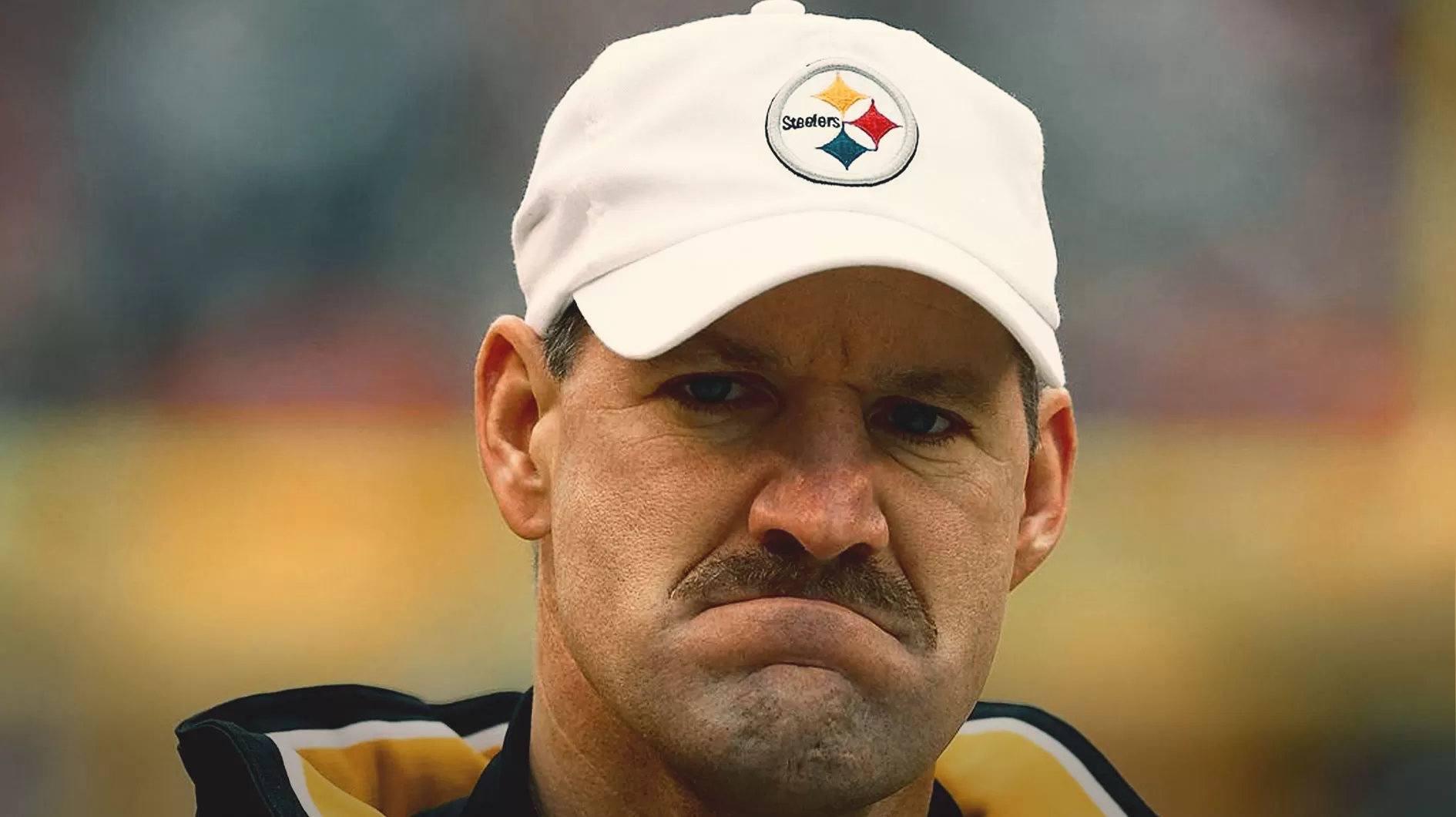
With Neil O’Donnell firmly implanted as the starter, that marked the end of Bubby Brister’s Pittsburgh Steelers career. Aside from Bradshaw and Roethlisberger, Neil O’Donnell would be the closest to Pittsburgh having another franchise quarterback. Still, O’Donnell would last just five seasons in Black and Gold before moving to the New York Jets, and Cincinnati Bengals for one season, and closing out his career in 2003 with the Tennessee Titans where he would start only eight games in five years.
Steelers fans, however, will remember Neil O’Donnell mostly for his performance in Super Bowl XXX a game in which he threw two critical touchdowns that made the difference in the Steelers' 27-17 loss to the Dallas Cowboys. O’Donnell’s two awfully thrown interceptions to Larry Brown made Brown the game’s M.V.P. even though he would never establish a solid NFL career. After that loss, O’Donnell became known as O’Dummy in Steelers Nation.
Unfortunately for Neil O’Donnell many Steelers fans believe he was looking past the Super Bowl to becoming a free agent which he did and signed with the New York Jets. Much to the glee of Steelers Nation, in his first season with the Green and White, the Jets finished 1-15. O’Donnell also suffered an injury but in his six starts, he was 0-6.
With O’Donnell no longer on the team, in his final year with the Steelers Bill Cowher drafted a young man in the 1995 draft named Kordell Stewart. Famous at the University of Colorado for an unbelievable “Hail Mary” play, Stewart in time would become simply known as “Slash.” That’s because as a Steeler he was used as a running back/quarterback/wide receiver and even punted
As a rookie, Stewart started two games but threw just seven passes. Five of those were completions. Slash was a dangerous runner though and in his NFL debut season, he ran the ball 15 times gaining 86 yards including one touchdown. In 1993 Bill Cowher brought in former Bears, Browns, and Packers quarterback Mike Tomczak to backup Neil O’Donnell. Not thinking Kordell Stewart was ready in 1996, Tomczak was handed the reigns and he started 15 games as the team finished 10-6 but lost to the Patriots in the divisional round.
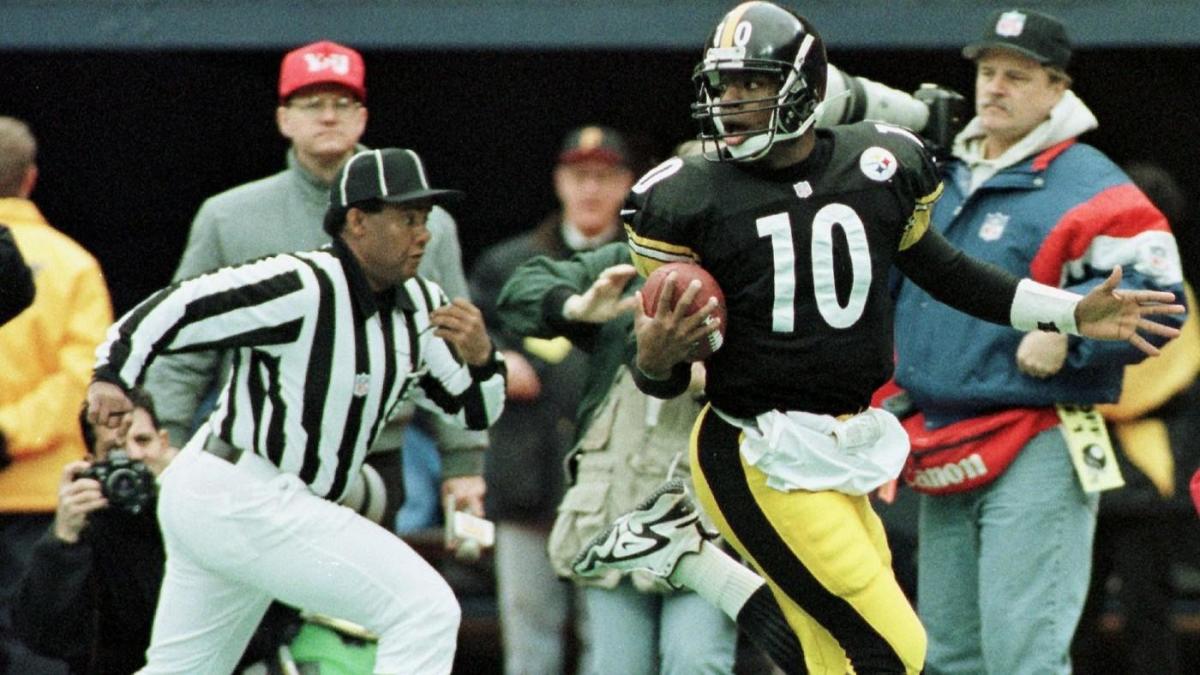
The Steelers had three quarterbacks in 1996, Tomczak, Stewart, and Jim Miller. Miller left the team the following season replaced by Mike Quinn as Kordell Stewart won the starting job over Mike Tomczak and him along with his teammates got to the AFC title game where they lost a close game to John Elway and the Denver Broncos 24-21. For Kordell Stewart, he was more of a novelty despite putting together a career year in 1997. He finished with 3,020 yards passing, 21 touchdown passes and ran for another 476 yards averaging 5.4 yards-per-carry the team's best. Slash also added 11 touchdowns on the ground.
What a difference a year makes because the following season Pittsburgh finished 7-9 with Stewart as the starter. Slash would toss 18 interceptions while putting together just 11 touchdown tosses. Like Chuck Noll before him, Bill Cowher had a second consecutive losing season in the last year of the 90s as the Steelers finished 6-10 and Kordell Stewart’s numbers continued to decline. He started in 12 of 16 games while Mike Tomczak started in the other five. Neither quarterback could generate much of a winning record.
The Steelers got their record above .500 in 2000 but just barely finished 9-7. Kordell Stewart managed to hold on to the starting role but Kent Graham was brought in from the New York Giants, but he was a bad acquisition lasting just one season in the ‘Burgh. Graham did start five games and lost three of those. The Steelers were starting to look past Slash and find that next quarterback that would be a steady force and be around for a long time.
In 2001, Bill Cowher stuck with Kordell Stewart one more time and he became “Slash” again throwing for 3,109 yards, completing 60.2% of his passes, and running the ball for 537 yards on just 96 carries. The Steelers got all the way to the AFC title game with a 13-3 record only to lose to Tom Brady and the Patriots.
Tommy Maddox who was a bust with the Denver Broncos had been brought onboard in 2000 after a solid career in the Arena Football League and he forced Kordell Stewart back to the bench and took over and was known as a real “gunslinger.” The change to Maddox brought about a whole new philosophy to Pittsburgh’s offense.
In his first full season as the Steelers' starting quarterback (2002), Maddox finished with a 7-3-1 record and 2,836 yards passing. His completion percentage was a nice 62.1 and he threw for 20 touchdowns. He was sacked only 26 times and Kordell Stewart was returned to his role of Slash. But it would be the last time Steelers fans saw Stewart in a Steelers uniform.
Stewart moved on to the Chicago Bears and started seven games for them but in Pittsburgh, it was now the Tommy Maddox show and in his final season as a starter with the Black and Gold, he and the Steelers ended up losing 10 of 16 games and Maddox while throwing for 3,414 yards, had 17 passes intercepted while hitting on only 18 touchdowns tosses. He was also sacked 41 times. A new era was about to begin in 2004.
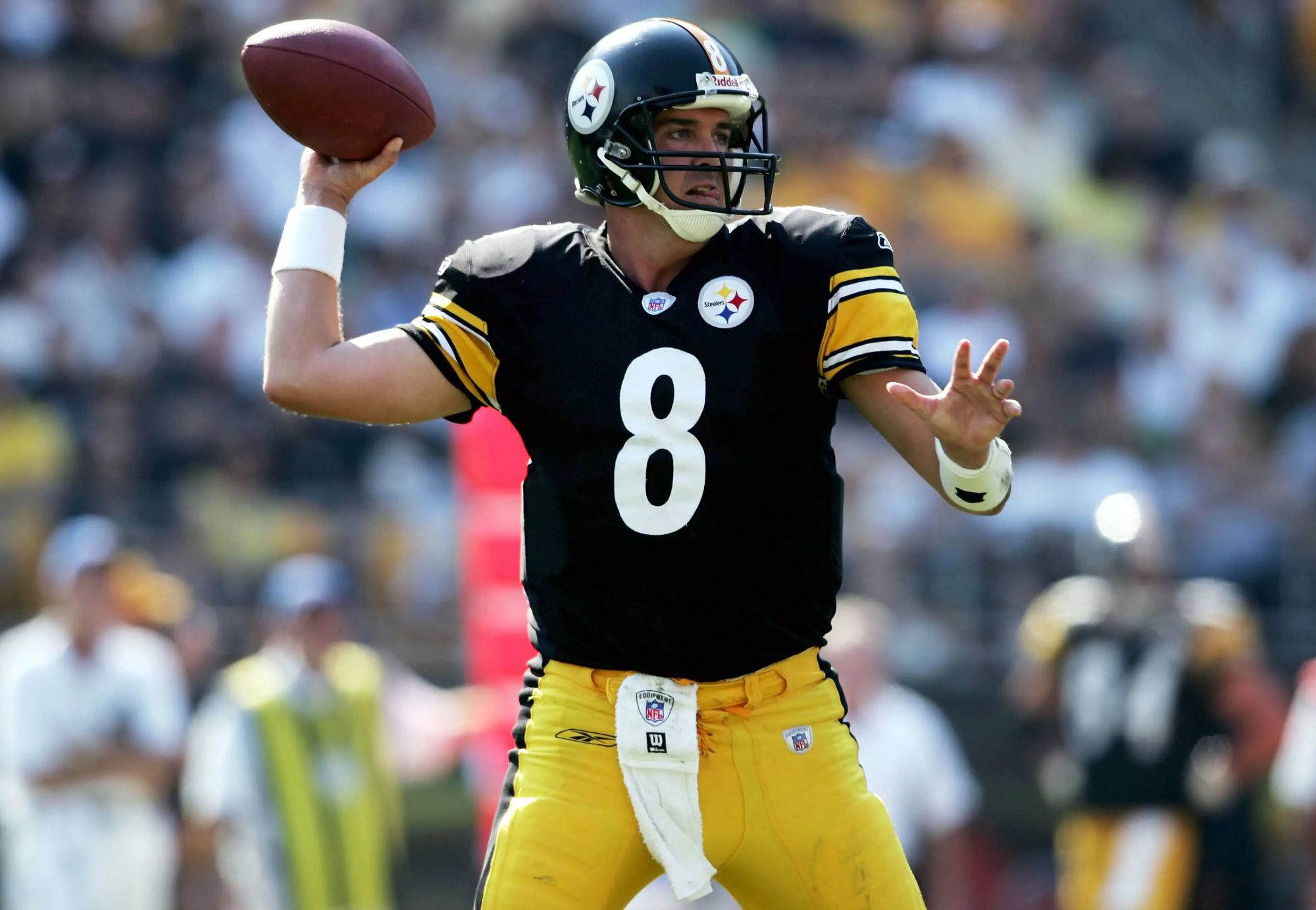
2004 is a season for any Steelers fan that can not be forgotten. Before the season began, the NFL draft took place early in the year and it became known as the “quarterback draft.” That’s because, in the first round, Eli Manning was the overall number one pick for the league by the San Diego Chargers but as it is well known, he refused to play there and facilitated trade to the New York Giants who a few picks later selected Phillip Rivers and the two teams exchanged picks.
With the 11th pick overall in that 2004 draft, the Pittsburgh Steelers found the franchise quarterback they had been looking for since the retirement of Terry Bradshaw. It was “Big Ben” Roethlisberger and the University of Miami (Ohio) product was miffed that he had been passed on by the previous 10 teams. Not counting the Chargers and Giants who wanted a QB as well, missing out on the future Hall of Fame quarterback were the Oakland Raiders, Arizona Cardinals, Washington Redskins, Cleveland Browns, Detroit Lions, Atlanta Falcons, Jacksonville Jaguars, and the Houston Texans.
Some of the front offices for the aforementioned teams as well as their respective fan bases probably kick themselves to this day for not picking Big Ben. The Raiders picked Robert Gallery who became a bust. The Cardinals however landed another Hall of Famer in Larry Fitzgerald. The ‘Skins landed Sean Taylor, a great secondary player who was tragically murdered.
But for the Cleveland Browns who have been forever seeking a franchise quarterback, their fan base was probably livid and still might be that they passed on a man that hails from their state. Today they are still looking for that special player at quarterback. Instead, they drafted Kelln Winslow II in 2004 and he only turned out to be trouble on and off the field.
The Houston Texans and Jacksonville Jaguars in retrospect probably wish they drafted Big Ben instead they ended up with Dunta Robinson and Reggie Williams respectively. Both were busts. So as Roethlisberger began his rookie season on the bench, an injury to Tommy Maddox in just the second game of the season gave way to Big Ben stepping in.
Not only did Roethlisberger become the starter after the second game loss to the Baltimore Ravens, but he and the Steelers also did not lose another regular season game the rest of the way in 2004. 14 straight wins later, Pittsburgh won the division and then in overtime defeated the New York Jets in the divisional playoffs only to lose their biggest nemesis the New England Patriots in the AFC title game. Had they won Big Ben would have had the opportunity to become the first rookie quarterback to win a Super Bowl. But it wasn’t meant to be.
By starting the 2004 season 2-0, Ben Roethlisberger and the Steelers had won 16 straight regular season games. Big Ben would remain a starter except for games missed due to injury until he retired in 2021. From the time Terry Bradshaw retired until Ben Roethlisberger became the star in 2004, the Steelers have had 19 different quarterbacks on the roster (Neil Graff, Reggie Collier, Mike Quinn, Pete Gonzalez, Kent Graham, Mark Malone, David Woodley, Scott Campbell, Bubby Brister, Steve Bono, Todd Blackledge, Rick Strom, Neil O'Donnell, Mike Tomczak, Jim Miller, Kordell Stewart, Tee Martin, Tommy Maddox, Charlie Batch).
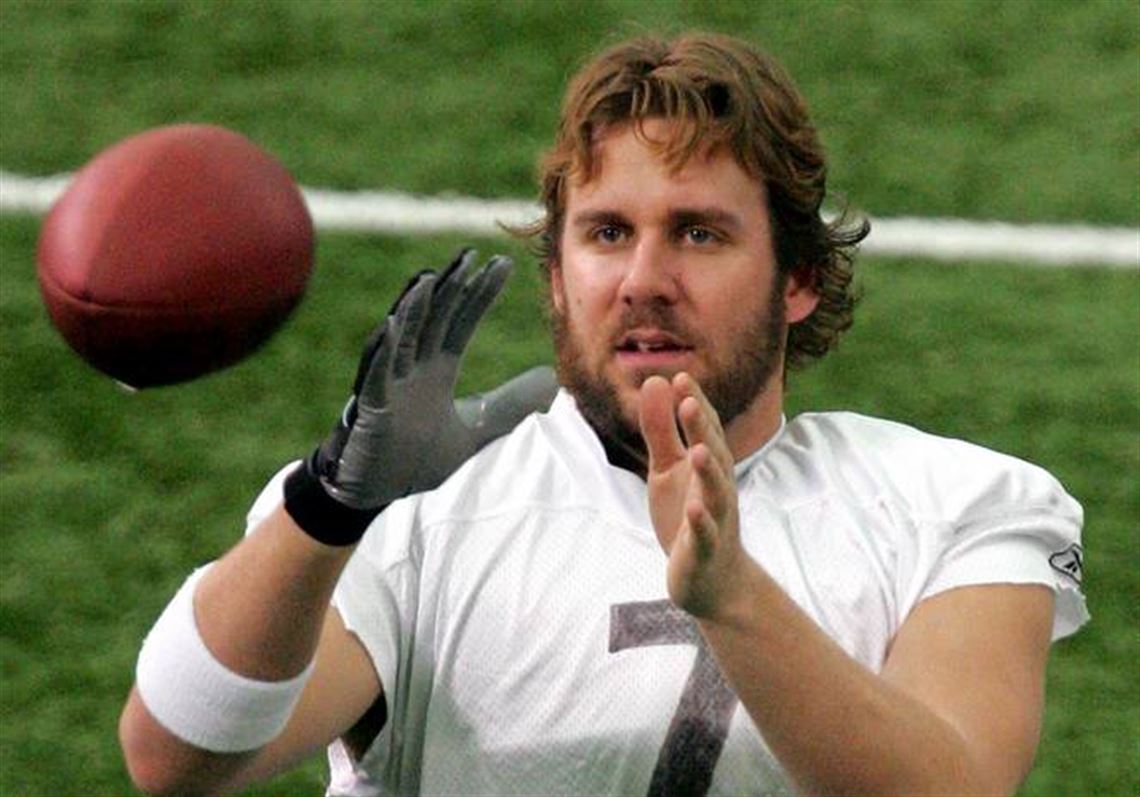
Since 1969 (53) years, the Pittsburgh Steelers have had only three head coaches (Chuck Noll, Bill Cowher, Mike Tomlin) and only two actual franchise quarterbacks. For the record, had the Steelers not drafted Terry Bradshaw, another Terry (Hanratty) would probably have been the starter. If you were not aware either the Steelers and Chicago Bears held a coin toss to determine who had the first overall pick in 1969 and Pittsburgh won that toss, drafted “The Blonde Bomber” and the rest is history.
The Bears subsequently traded their second pick to Green Bay who then picked Mike McCoy. Just for comparative purposes, mentioned before was the failure of the Cleveland Browns to find themselves a franchise quarterback. Since Terry Bradshaw was drafted in 1970 until Ben Roethlisberger’s retirement in 2021, the Browns have had a total of 73 quarterbacks on their roster either as starters or backups. Some of the well-known names for the Browns that never became the prototype QBS were: Brian Sipe, Don Strock, Mike Tomczak, Mark Rypien, Jeff Garcia, Luke McCown, Trent Dilfer, Bruce Gradkowski, Jake Delhomme, Jason Campbell, Robert Griffin III, Drew Stanton, Tyrod Taylor, Mike Phipps, Brian Sipe, Bernie Kosar, Vinny Testaverde, Ty Detmer, Tim Couch, Kelly Holcomb, Charlie Frye, Derek Anderson, Brady Quinn, Seneca Wallace, Colt McCoy, Brandon Weeden, Brian Hoyer, Johnny Manziel, Josh McCown, Terrelle Pryor, Baker Mayfield, and Case Keenum.
So the bottom line for the Pittsburgh Steelers is this…Mitch Trubisky, is he the next Bradshaw or Roethlisberger? Or is rookie Kenny Pickett priming to become the next franchise quarterback and spend the next 10-20 years behind center just as the two legendary quarterbacks that preceded him? Again, the more I watch Trubisky the more he reminds me of Mark Malone and that is not where he wants to be believe me.














